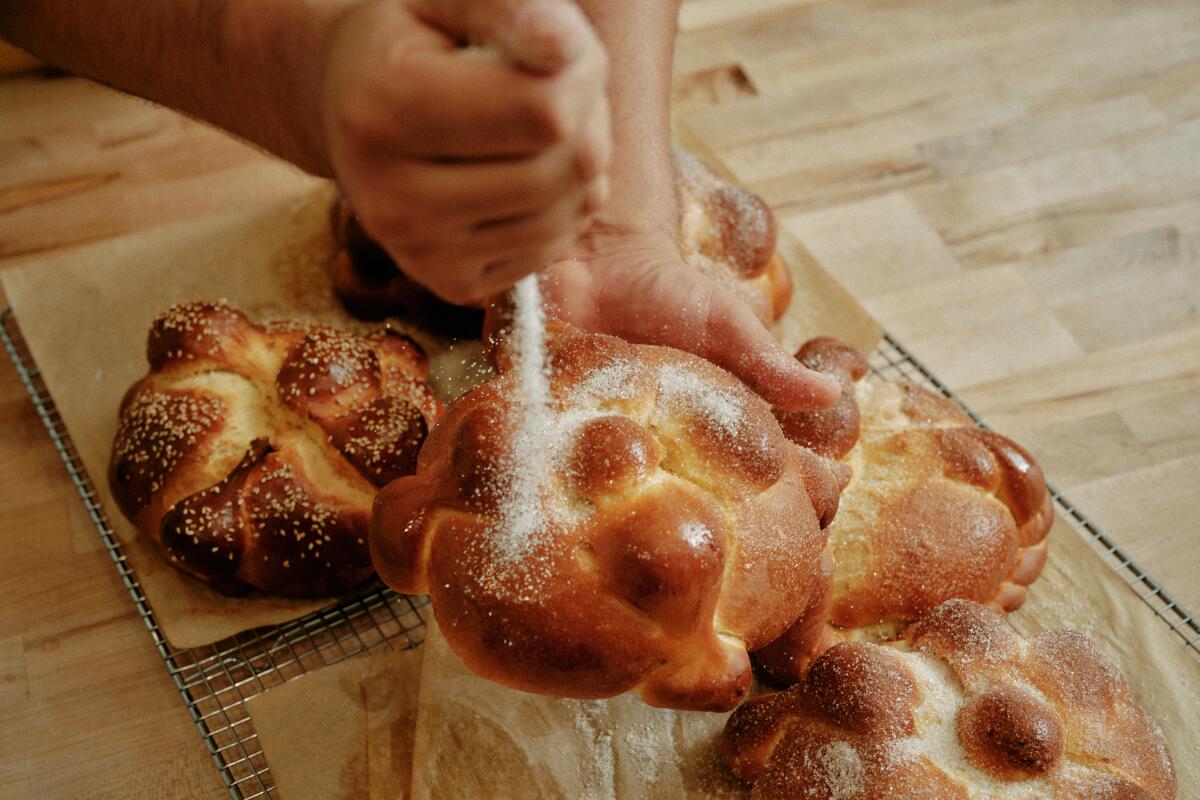The favorite stories written by the Food team in 2024

Plenty of nicknames knock around the Internet to describe the blurry stretch of time between Christmas (Chrismukkah this year!) and New Year’s Day. “Feral Week” is my favorite. It’s when I disappear into immersive bouts of reading. In that spirit, for all of us, I asked my colleagues to look back over the year and name the one favorite story of theirs published by The Times in 2024.
Our favorite stories we wrote in 2024
“My favorite story is also my most personal,” says assistant Food editor Danielle Dorsey. “It provides insight into the foodways of Black Southern Californians, of which I proudly represent the second generation on my maternal side. Specifically, the essay delves into the rise of what I came to dub the ‘Black taco,’ first in Black homes in the region and later in Black-owned restaurants. The essay shares the influence and inspiration that Black home cooks gleaned from Mexican neighbors and local taquerias (in particular the ‘gringo’ taco), as well as how their recipes diverge from the typical preparations.
“In addition to the main essay, I share a list with 9 L.A. recommendations for trying Black tacos as well as a profile of a clandestine taco stand that gained international exposure after a spotlight in Issa Rae’s HBO series ‘Insecure.’”

Deputy Food editor Betty Hallock visited Arturo Enciso at his extraordinary bakery Gusto in Long Beach to document his method for preparing the iconic bread of Día de Muertos. “Enciso compares making bread to a spiritual practice, a way of learning about himself as much as about baking,” she says. “Pan de muerto — in the style most common in the state of Mexico — is round, fluffy and decorated with symbolic bones or the tears of the goddess Chīmalmā. Enciso’s are flavored with traditional orange blossom water and fennel. And they are so delicious I was inspired to travel to Mexico City during the week of Muertos, when families honor loved ones who have died — and the namesake sweet bread makes its appearance at every bakery in town (you can smell the pastries from the street) and on altars erected especially for the holiday.
“Someone I met told me, ‘It isn’t Día de Muertos season unless you’ve eaten at least five pans de muerto.’ I’m sure I ate a dozen, in the style of not only Mexico City but also Puebla (dusted with bright pink sugar) and Guanajuato (shaped as a human figure and frosted in pure white). Gusto’s version fueled an obsession, and I’m grateful I now know how to make them myself (here’s the recipe) — but will probably always visit Enciso’s bakery during Muertos season.”

Columnist Jenn Harris chose her profile of chef Minh Phan, who previously ran the restaurants Phenakite and Porridge + Puffs. Her feature illuminates the confluence of reasons why Phan stepped away from her businesses to become the artist in residence at a nonprofit called Food Forward. About the piece Jenn says, “Minh is someone who tirelessly works to bring more equity to the entire restaurant industry, from the farmers to the people who prepare and serve our food. I’m grateful that she trusted me with telling the story of why she decided to leave her restaurants behind, lean in to her art and work for a nonprofit.”
Filed under “favorite” not in an upbeat sense but in an important one: In May, The Times published a story on the spate of restaurant closings in Los Angeles, for which reporter Stephanie Breijo spent months interviewing chefs and restaurant owners. The factors are many, with specific circumstances and stories behind every closure, but it lays bare why it’s been a year of crisis for so many in the L.A. restaurant industry. A must read.
Reporter Cindy Carcamo points out her extensively reported story, “Fast-growing asparagus once flourished on California farms. Why is it disappearing?” She details the rise and fall of the vegetable as a Golden State crop, which only a handful of farmers now concentrate on producing. “At its most recent peak in 2000,” she writes, “California farmers harvested 37,000 acres of asparagus, according to the state Department of Food and Agriculture. About 10% of that acreage has been lost every year since. Now there are fewer than 3,000 acres of asparagus left in the Golden State, according to the latest available data. How this happened can be read as a cautionary tale for California agriculture at large, farmers and asparagus industry insiders said.”

For her profile “A generation after Nobu, Peruvian sushi blooms in Long Beach,” Sarah Mosqueda says, “I spent a lot of time getting to know Eduardo Chang and Daiwa Wong, owners of Sushi Nikkei. While the dynamic of running a restaurant with your partner was one that was familiar to me, I was less familiar with the history of Japanese emigrants and their descendants in Peru. I was so thankful to Chang and Wong for sharing their story with me.”
The entire team pitched in for months for our 101 Best Tacos in Los Angeles mega-project published in July. Food editor Daniel Hernandez wrote an accompanying essay on the meanings behind our signature food. As he says, “I was able to drill down on some origin points and broader cultural analysis on why L.A. is so obsessed with tacos and reached such a bountiful excess of this, the most versatile dish of them all.” Read why he thinks the city is in a “fourth wave” of tacos, what contributes to the “chaotic abundance” and this truism: “If you have this hunch in your belly that tells you tacos in L.A. somehow taste better on the street, you’re not alone. I’m also a believer, yet I’ve found no one able to explain the science of it.”

Laurie Ochoa selects two pieces — from this very newsletter we co-author — that dive into her travels through Italy this summer. Both make me very hungry. In the first she writes, “Italy’s Umbria region is a part of the world where roadside porchetta trucks are almost as numerous as taco trucks in Los Angeles. … Yet in recent years, I’ve found myself craving the panini made by a sandwich maker in Umbria who is forging his own path.”
For the second, she writes about the tiny village of Castelluccio, in a region famous for the deliciousness of its lentils: “A single image cannot capture the beauty of the plains that attract sheepherders and their flocks, trekkers off the trails of Monti Sibillini National Park, hang gliders who soar above wild and trained horses plus daytrippers with all manner of pricey photo equipment or cheap cellphones for selfies. I come for lunch. … Taverna Castelluccio, run by Giuseppe ‘Peppe’ Caponecchi and his family, is my kind of destination restaurant with many rewards for those seeking honest cooking from local ingredients. Not just the lentils, but all kinds of salumi. Farro and chickpeas. Pecorino cheese. Black summer truffles.”
And me?
Mine also involves travel, though far closer to Los Angeles. I spent more time this year wandering California, taking fresh looks at what’s happening with restaurants in San Diego and Palm Springs. But it was especially fulfilling to spend several weeks in the Bay Area. San Francisco has been many things to me, including home (I worked briefly for the San Francisco Chronicle in the 2000s) and a culinary mecca I’ve known as a teenager, a fruit-obsessed pastry cook in my 20s and, during nearly a quarter-century as a critic, a lodestar with an ever-evolving influence over how we think about food. You can scan this guide to 35 San Francisco restaurants, bakeries, bars and two outstanding options for coffee and tea purely as a listicle — but if you read through it, you’ll find some autobiography woven in there as well.

Just in time for New Year’s celebrations: The rise of American bubbles
For your holiday festivities: Patrick Comiskey dives into the new age of superb Californian sparkling wine. “For years, domestic sparkling wines would have been lumped into an ice bucket of ‘lesser-thans,’” he writes. “But no longer. Adjustments in the vineyard and modest tweaks in the cellar have rendered a new style of California bubbles. At their best they can express a sense of place as well as or better than many of their French counterparts.”
For specific guidance, he also names 10 standout California sparklers, and where to find them in Los Angeles.

You’re reading Tasting Notes
Our L.A. Times restaurant experts share insights and off-the-cuff takes on where they’re eating right now.
You may occasionally receive promotional content from the Los Angeles Times.
Also ...
- Headed to a film before we settle into January? Emily Beyda names 10 of the best places to pick up movie snacks to slip into the theater or enjoy before or after, including a Filipino grocer, a Fairfax burger joint and a local mini-chain with Tex-Mex breakfast tacos.
- Tiffany Tse rounds up 25 strong choices for New Year’s Eve and New Year’s Day meals.
- Stephanie talks with chef Johnny Lee, who is putting his spin on Malaysian cuisine after years of journeys and research at Rasarumah in Historic Filipinotown.
- In case you missed it, the Food team selected our favorite dishes of 2024.
Eat your way across L.A.
Like what you're reading? Sign up to get it in your inbox every week.
You may occasionally receive promotional content from the Los Angeles Times.
Eat your way across L.A.
Get our weekly Tasting Notes newsletter for reviews, news and more.
You may occasionally receive promotional content from the Los Angeles Times.



